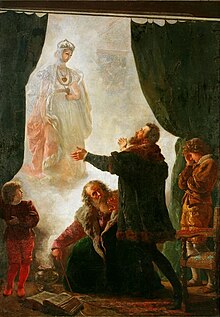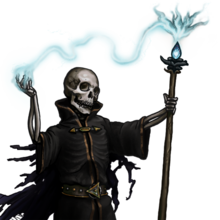Undead

Undead is a collective name for fictional, mythological, or legendary beings that are deceased yet behave as if alive. Undead may be incorporeal, such as ghosts, or corporeal, such as vampires and zombies. Undead are featured in the legends of most cultures and in many works of fantasy and horror fiction.
Bram Stoker considered the term "The Un-Dead" for the original title for his novel Dracula (1897),[1] and its use in the novel is mostly responsible for the modern sense of the word. The word does appear in English before Stoker but with the more literal sense of "alive" or "not dead", for which citations can be found in the Oxford English Dictionary. Stoker's use of the term refers only to vampires, and the extension to other types of supernatural beings arose later. Most commonly, it is now taken to refer to supernatural beings which had at one time been alive and continue to display some aspects of life after death, but the usage is highly variable.
Creation
This section possibly contains original research. (September 2007) |
Mary Wollstonecraft Shelley's novel Frankenstein, or the Modern Prometheus introduced a new variant of undead, the dead brought back to "life" by science, though Frankenstein's creature bears some similarity to a golem. Similar works include H. P. Lovecraft's short story "Herbert West—Reanimator" and the Re-Animator film franchise inspired by the story.
Both legend and popular culture discuss various methods for creating undead creatures. Most involve the reanimation of a corpse, as with zombies, skeletons, and ghouls. Regarding ghosts, the spirit lives on after death, forming an intangible physical body that often mirrors the one the spirit had in life. Rituals propitiating the uneasy spirits of the dead were a feature of ancient Greek religion (keres), ancient Roman religion (lemures), and Hinduism.
In some cases, the undead, especially skeletons and zombies, are under the control of a necromancer. In other cases, such as zombies as depicted in film, the undead existence is passed on like a curse or disease. With liches, the powers of undead are sought after by the participant of a magical ritual that turns them from a living being to a lich. Ghosts are said to be kept in their undead state by willpower, either from a keen desire to remain with the living or from a wish to see something completed that they could not do during their lifetime. Revenants are a corporeal analog for ghosts in this manner, their independence setting them apart from the typically mindless skeleton or zombie. However note that, while ghosts are sometimes portrayed as benevolent or at least innocuous, the appearance of a revenant in folklore or fiction is almost universally horrific with the exception of avenging heroes such as Spawn and The Crow.
Creation of Zombies
Zombies are a part of Voodoo, a religion which originated in Haiti and Western Africa. The necromancer -- known as a Bokor -- selects a victim. The Bokor administered a cocktail of poisonous substances, most notably pufferfish. Over the course of a couple of weeks, the victim would assume a death-like state, and be buried, only to be dug up by the Bokor. The victim, suffering from brain damage, would seem to many to be a reanimated corpse. This process is assumed to work because of the brain damaging properties of the poison. However, a verified specimen has yet to be found.
Forms of Undead
- Revenant
- Skeleton
- Zombie
- Ghoul
- Ghost
- Wraith
- Spectre
- Lich
- Ghast
- Mummy
- Vampire
- Wight
- Draug or Draugr
- Frankenstein monster
- Tilagor
- Tizamar
- Inferius
Fiction and films
Many films have been made about the undead, usually zombies, and mummies, including such fiction as Dracula, The Crow, Night of the Living Dead, and The Mummy.
Games and popular culture

Undead are a popular adversary in fantasy and horror settings. They feature prominently in many role-playing games, computer role-playing games, MMORPGs and strategy games. In such games, special rules are often given for the undead.
In Dungeons & Dragons and similar systems, clerics can attempt to "turn" undead by invoking their patron deities or channeling "positive energy" (other-dimensional life energy, which animates and heals living creatures, and is the antithesis of negative energy, which animates and heals undead creatures.) This forces the undead creature away from the cleric; powerful clerics are capable of completely destroying weaker undead creatures with this ability. Although the act of turning away the undead relies primarily on power of faith, a holy symbol is usually required as a focus for the divine power being invoked. Clerics of evil gods can rebuke and control the undead in a similar fashion, by means of necromancy.[2]
Similarly in the Thief series, undead feature prominently, in many different shapes and forms.[3] The many living factions present in the games violently oppose these beings and see them as abhorrent. To combat them, magic and fire are widely used. The protagonist player character Garrett can also deter them with either explosives or vials of blue liquid called "Holy Water".
In Dungeons & Dragons and other games such as Final Fantasy, undead can be damaged by using magical effects that heal normal living beings.[4]
In videogame settings such as Poxnora and World of Warcraft undead NPC's or players gain advantages that come with the undead state, such as immunity to Fear mechanics, Mind Control, Bleeding, Disease, Poison and a variety of other effects, be it physical or mental, that do not apply to creatures with no living flesh, blood or a conscious state of mind. In these gamesettings undead also gain advantages such as being Incorporeal, disease spreading or being some form of spellcaster who is further augmented by his undead state. (Undead spellcasters tend to be conscious in these videogame settings, though the same rules of no Fear or Mind Control apply.)
Undead characters appear in many roles, be it a mindless horde of opponents (such as zombies or skeletons) or a thoughtful, plotting villain . Some games feature undead playable characters, such as Vampire: The Masquerade and World of Warcraft. Others, such as Diablo 2, allow the player to take on the role of a Necromancer and raise undead from corpses.
In some stories and settings, such as the Lorien Trust LARP, the word "unliving" is used as a preferential synonym. In reference to the political correctness movement, the undead are sometimes jokingly referred to as the "living-impaired".
In philosophy
Jacques Derrida used the myth of the undead as a means to deconstruct the binary opposition between life and death.
In science
Being a construct of mythology and superstition, the term "undead" is not used in science. In science and medicine, a person that is revived from clinical death is regarded as alive because biological functions associated with life have been restored. The capacity for dead matter to behave as though it were alive in fictional/mystical representations of the "undead" is not known to science at this time.
See also
- Monster
- Afterlife
- Maschalismos
- Philosophical zombie
- Death and Death (personification)
- Life extension
- List of species in folklore and mythology
- List of species in folklore and mythology by type
- List of species in fantasy fiction
Footnotes and references
- ^ "About Dracula". Retrieved 2006-05-21.
- ^ "Special Attacks: Turn Or Rebuke Undead". Retrieved 2006-05-11.
- ^ "Thief wiki entry for "Undead"". Retrieved 2008-10-12.
- ^ "Spells: Cure Light Wounds". Retrieved 2006-05-21.
